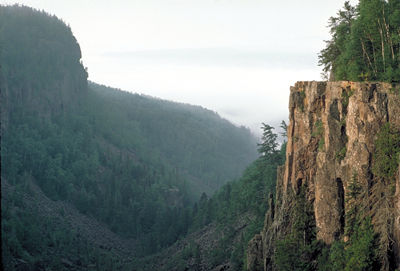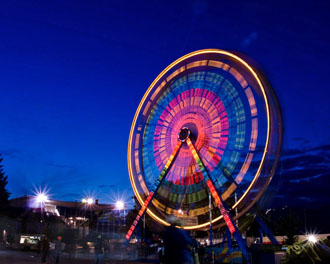Browse "Places"
-
Article
Ottawa
Ottawa, Ontario, incorporated as a city in 1855, population 1,017,449 (2021 census), 934,243 (2016 census). The City of Ottawa is the capital of Canada and is located on the Ottawa River on Ontario's eastern boundary with Québec, about 200 km west of Montréal. The name "Ottawa" is thought to derive from an Algonquian-speaking First Nation of the same name, probably from a word meaning "to trade" (see Odawa). Amalgamation, on 1 January 2001, merged "old" Ottawa with 11 area municipalities and the Regional Municipality of Ottawa-Carleton to create a “new” city. The amalgamated city encompasses the municipalities of Ottawa, Vanier, Nepean, Kanata, Gloucester and Cumberland; the townships of Rideau, West Carleton, Goulbourn and Osgoode; and the village of Rockcliffe Park.
"https://d2ttikhf7xbzbs.cloudfront.net/media/media/604a383c-e913-458a-b6b2-759c08afa1f6.jpg" // resources/views/front/categories/view.blade.php
https://d2ttikhf7xbzbs.cloudfront.net/media/media/604a383c-e913-458a-b6b2-759c08afa1f6.jpg
-
Article
Music in Ottawa
Canada's capital city, situated in Ontario on the Ottawa River. Settled in the early 1800s, it was called Bellows' Landing (1810), Richmond Landing (1811), and Bytown (1826) after Col John By, who, 1826-32, supervised the building of the Rideau Canal.
"https://development.thecanadianencyclopedia.ca/images/tce_placeholder.jpg?v=e9dca980c9bdb3aa11e832e7ea94f5d9" // resources/views/front/categories/view.blade.php
https://development.thecanadianencyclopedia.ca/images/tce_placeholder.jpg?v=e9dca980c9bdb3aa11e832e7ea94f5d9
-
Article
Otterburn Park
The name Otterburn is a reminder of the birthplace of Sir Joseph Hickson, general manager of the GRAND TRUNK RAILWAY from 1874 to 1890.
"https://d2ttikhf7xbzbs.cloudfront.net/media/media/3343e517-5699-4e5b-8d48-17cc5952b771.jpg" // resources/views/front/categories/view.blade.php
https://d2ttikhf7xbzbs.cloudfront.net/media/media/3343e517-5699-4e5b-8d48-17cc5952b771.jpg
-
Article
Ouimet Canyon Provincial Park
A spectacular, steep-sided gorge cut into volcanic rock of Lake Superior's northern shore is protected in Ouimet Canyon Provincial Park (established 1972, 777 ha), 65 km northeast of Thunder Bay, Ontario.
"https://d2ttikhf7xbzbs.cloudfront.net/media/media/fe2420b7-d26b-483e-b339-46a75ac65e13.jpg" // resources/views/front/categories/view.blade.php
https://d2ttikhf7xbzbs.cloudfront.net/media/media/fe2420b7-d26b-483e-b339-46a75ac65e13.jpg
-
Article
Outlook
The town of Outlook developed as a result of railway land development. In 1908 the Canadian Pacific Railway purchased the farm of a local homesteader and announced that it would be developed as a townsite.
"https://development.thecanadianencyclopedia.ca/images/tce_placeholder.jpg?v=e9dca980c9bdb3aa11e832e7ea94f5d9" // resources/views/front/categories/view.blade.php
https://development.thecanadianencyclopedia.ca/images/tce_placeholder.jpg?v=e9dca980c9bdb3aa11e832e7ea94f5d9
-
Article
Outremont
Outremont, one of the smallest cities in terms of area of the MONTRÉAL Urban Community (MUC), is one of the most affluent, beautiful and picturesque residential communities on the island.
"https://development.thecanadianencyclopedia.ca/images/tce_placeholder.jpg?v=e9dca980c9bdb3aa11e832e7ea94f5d9" // resources/views/front/categories/view.blade.php
https://development.thecanadianencyclopedia.ca/images/tce_placeholder.jpg?v=e9dca980c9bdb3aa11e832e7ea94f5d9
-
Article
Owen Sound
Owen Sound, Ont, incorporated as a city in 1920, population 21 688 (2011c), 21 753 (2006c). The City of Owen Sound is located on an inlet at the south end of GEORGIAN BAY, at the outlet of the Sydenham and Pottawatomi rivers, 190 km northwest of Toronto.
"https://development.thecanadianencyclopedia.ca/images/tce_placeholder.jpg?v=e9dca980c9bdb3aa11e832e7ea94f5d9" // resources/views/front/categories/view.blade.php
https://development.thecanadianencyclopedia.ca/images/tce_placeholder.jpg?v=e9dca980c9bdb3aa11e832e7ea94f5d9
-
Article
Oxbow Archaeological Site
The Oxbow site is located on a low terrace along the north bank of the Little Southwest Miramichi River, 1 km west of its confluence with the Northwest Miramichi, Northumberland County, New Brunswick.
"https://d2ttikhf7xbzbs.cloudfront.net/media/media/0ca6861b-eca0-4e2e-a2dd-b774d34d4352.jpg" // resources/views/front/categories/view.blade.php
https://d2ttikhf7xbzbs.cloudfront.net/media/media/0ca6861b-eca0-4e2e-a2dd-b774d34d4352.jpg
-
Article
Pacific National Exhibition (PNE)
The 6-hectare (15-acre) amusement park known today as "Playland" has been host to millions since its opening on the PNE site in 1910. Named "Happy Land" in 1926, the park moved to its current location in 1958 when the name was changed to "Playland.
"https://d2ttikhf7xbzbs.cloudfront.net/media/media/ad15874f-1d61-4a41-a1bb-d04030dc1c1a.jpg" // resources/views/front/categories/view.blade.php
https://d2ttikhf7xbzbs.cloudfront.net/media/media/ad15874f-1d61-4a41-a1bb-d04030dc1c1a.jpg
-
Article
Pacific Ocean and Canada
The Pacific Ocean is the world’s largest ocean. It covers more than 30 per cent of the Earth’s surface — an area roughly the same as the Atlantic and Indian oceans combined. Canada’s relationship with the Pacific Ocean is synonymous with the West Coast of British Columbia. The province’s entire ocean shoreline, including the coasts of Vancouver Island and Haida Gwaii, form Canada’s Pacific coastal region. More than 75 per cent of the province’s 5 million residents live within 50 km of the coast.
"https://d2ttikhf7xbzbs.cloudfront.net/media/new_article_images/PacificOcean/PacificOceanMapEN-1.png" // resources/views/front/categories/view.blade.php
https://d2ttikhf7xbzbs.cloudfront.net/media/new_article_images/PacificOcean/PacificOceanMapEN-1.png
-
Article
Pacific Rim
The term Pacific Rim has been used to refer to all those countries with coastlines bordering the Pacific Ocean. However, in recent years the term has become synonymous with the Asia Pacific region which encompasses East and Southeast Asia, South Asia, Australia, New Zealand and North America.
"https://development.thecanadianencyclopedia.ca/images/tce_placeholder.jpg?v=e9dca980c9bdb3aa11e832e7ea94f5d9" // resources/views/front/categories/view.blade.php
https://development.thecanadianencyclopedia.ca/images/tce_placeholder.jpg?v=e9dca980c9bdb3aa11e832e7ea94f5d9
-
Article
Pacific Rim National Park Reserve
Pacific Rim National Park Reserve (est 1970, 285.8 km2) stretches for 105 km along the rugged west coast of Vancouver Island.
"https://d2ttikhf7xbzbs.cloudfront.net/media/media/14e848e6-2343-4115-a5a5-78d718430c10.jpg" // resources/views/front/categories/view.blade.php
https://d2ttikhf7xbzbs.cloudfront.net/media/media/14e848e6-2343-4115-a5a5-78d718430c10.jpg
-
Article
Paddle Prairie Metis Settlement
The Paddle Prairie Metis Settlement is one of eight Métis Settlements in Alberta. The community is located in the northwest corner of the province near the Peace River. It is 1,739 km2, or roughly two and a half times the size of Edmonton. This makes Paddle Prairie the largest of the eight settlements in terms of area. It also makes it larger than the largest First Nation reserve in both the province and the country. (Blood 148, held by Kainai Nation in southern Alberta, is 1,342.9 km2.) The population of Paddle Prairie is 536, according to the settlement’s 2019 census. In addition, people may be a member of the settlement but live elsewhere.
"https://d2ttikhf7xbzbs.cloudfront.net/media/new_article_images/PPMS/School.jpg" // resources/views/front/categories/view.blade.php
https://d2ttikhf7xbzbs.cloudfront.net/media/new_article_images/PPMS/School.jpg
-
Article
Paldi
Paldi, British Columbia was established in 1917, about 75 km northwest of Victoria. It was one of the first multi-ethnic, migrant mill towns on Vancouver Island. Sikh entrepreneur Mayo Singh (born Mayan Singh Manhas) founded the community. He named Paldi after his own village in District Hoshiarpur in Punjab, India. (Singh originally named Paldi after himself, calling the settlement Mayo Siding. However, because there was already a town named Mayo in Yukon, Singh changed the name to Paldi in 1936.) Though Paldi no longer has a registered population, it remains a symbol of successful, intercultural living in Canada.
"https://d2ttikhf7xbzbs.cloudfront.net/MayoSingh/ChildrenAndTemple.jpg" // resources/views/front/categories/view.blade.php
https://d2ttikhf7xbzbs.cloudfront.net/MayoSingh/ChildrenAndTemple.jpg
-
Article
Paradise
Paradise, NL, incorporated as a town in 1981, population 17 695 (2011c), 12 584 (2006c). The Town of Paradise is situated inland approximately 13 km from downtown ST JOHN'S.
"https://development.thecanadianencyclopedia.ca/images/tce_placeholder.jpg?v=e9dca980c9bdb3aa11e832e7ea94f5d9" // resources/views/front/categories/view.blade.php
https://development.thecanadianencyclopedia.ca/images/tce_placeholder.jpg?v=e9dca980c9bdb3aa11e832e7ea94f5d9
